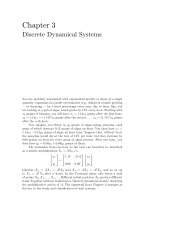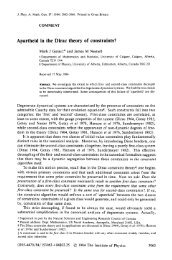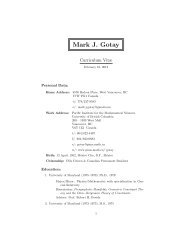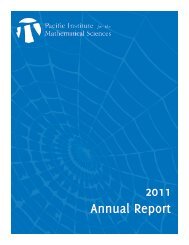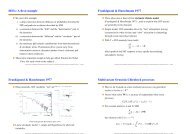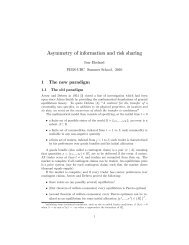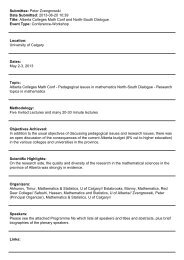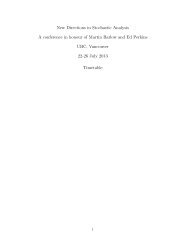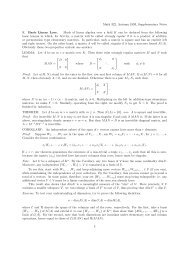45 PRIMA 2013 AbstractsJian ZhouTsinghua University, Chinajzhou@m<strong>at</strong>h.tsinghua.edu.cnWe will present a formula for Gopakumar-Vafa BPSinvariants of local Calabi-Yau geometries given by thecanonical line bundles of toric surfaces under some technicalconditions. This verifies and extends a conjecturemade by K<strong>at</strong>z-Klemm-Vafa based on M-theory.Special Session 23Triangul<strong>at</strong>ed C<strong>at</strong>egories in Represent<strong>at</strong>ionTheory of AlgebrasDerived simple algebrasLidia Angeleri HügelUniversity of Verona, Italylidia.angeleri@univr.itAn algebra is said to be derived simple if its derived c<strong>at</strong>egorycannot be deconstructed into ‘smaller’ derived c<strong>at</strong>egories,more precisely, it is not the middle term of a nontrivialrecollement where the two outer terms are againderived c<strong>at</strong>egories of algebras.We will see th<strong>at</strong> being derived simple strongly dependson the choice of derived c<strong>at</strong>egories: whether <strong>at</strong> boundedor unbounded level, whether considering finitely gener<strong>at</strong>edor arbitrary modules. We will clarify the connectionbetween the different choices by discussing when recollementscan be lifted or restricted between different levelsof derived c<strong>at</strong>egories. We will then characterize derivedsimpleness on each level in terms of the height of ladders,th<strong>at</strong> is, the number of adjacent recollements <strong>at</strong> unboundedlevel. This is joint work with Steffen Koenig,Qunhua Liu, Dong Yang.The decor<strong>at</strong>ed mapping class group of amarked surfaceThomas BrüstleBishops’s University and Université de Sherbrooke,Canad<strong>at</strong>bruestl@ubishops.caThe main character of this talk is the decor<strong>at</strong>ed mappingclass group MCG p(S, M) of a marked surface (S, M). Weshow th<strong>at</strong> (in most cases) it is isomorphic to a groupformed by automorphisms of the cluster algebra associ<strong>at</strong>edto (S, M), which can also be interpreted as a groupof auto-equivalences of the corresponding cluster c<strong>at</strong>egoryC(S, M). Moreover we describe the suspension functor ofC(S, M) geometrically, as an element in the decor<strong>at</strong>edmapping class group of (S, M).Autoequivalences under derived equivalencesRagnar-Olaf BuchweitzUniversity of Toronto Scarboroughragnar@utsc.utoronto.caThere are many examples where derived c<strong>at</strong>egories ofcoherent sheaves on some smooth projective variety areequivalent to the derived c<strong>at</strong>egory of finite length modulesover an artinian algebra, or to the singularity c<strong>at</strong>egoryof graded modules over a graded Gorenstein algebra,or both.In these case, often one of the partners in the derivedequivalences carries obvious autoequivalences, such astwists by line bundles on the geometric side or degreeshifts in the graded case, th<strong>at</strong> are quite mysterious onthe equivalent incarn<strong>at</strong>ions.We will review this situ<strong>at</strong>ion and explain some classicalexamples where the "obvious" autoequivalences on oneside can now be understood on the other side. Part ofthis is joint work in progress with Lutz Hille.Singular equivalences with examplesXiao-Wu ChenUniversity of Science and Technology of China, Chinaxwchen@mail.ustc.edu.cnTwo finite dimensional algebras are said to be singularlyequivalent if there is a triangle equivalence between theirsingularity c<strong>at</strong>egories in the sense of Buchweitz and Orlov;this triangle equivalence is called a singular equivalence.We will report recent progress on singular equivalenceswith examples.The represent<strong>at</strong>ion type of non-degener<strong>at</strong>eQPsChristof GeissN<strong>at</strong>ional Autonomous University of Mexico, Mexicochristof@m<strong>at</strong>em.unam.mxLet Q be a 2-acyclic quiver, and W a non-degener<strong>at</strong>epotential for Q. We show, th<strong>at</strong> up to a few exceptionsthe Jacaobian algebra P(Q, W ) is tame if and only if thequiver is mut<strong>at</strong>ion finite.The exceptions are the following: The mut<strong>at</strong>ion finitequivers X 6 , X 7 (found by Derksen and Owen) and the m-Kronecker quiver for m ≥ 3 yield wild Jacobian algebras.The mut<strong>at</strong>ion finite quivers T 1 and T 2 corresponding totriangul<strong>at</strong>ions of a torus with one puncture resp. withone marked point admit non-degener<strong>at</strong>e potentials whichcan be either tame or wild.The tame cases include virtually all known "derivedtamephenomena": (extended) Dynkin, tubular, skewedclannishand deform<strong>at</strong>ions. Thus we obtain many examplesof "tame" triangulal<strong>at</strong>ed 2-CY c<strong>at</strong>egories.If time permits we discuss the uniqueness of nondegener<strong>at</strong>epotentials for most mut<strong>at</strong>ion finite quivers.Geigle-Lenzing spaces and canonical algebrasof dimension d (I)Martin HerschendNorwegian University, Norwaymartinh@m<strong>at</strong>h.nagoya-u.ac.jpThis is the first half of a report on ongoing joint workwith Osamu Iyama, Hiroyuki Minamoto, and Steffen Oppermann.The second half will be given by Osamu Iyama.Weighted projective lines were introduced by Geigle andLenzing. One key property of these is th<strong>at</strong> they give riseto hereditary c<strong>at</strong>egories with tilting objects, whose endomorphismrings are canonical algebras. Both weightedprojective lines and canonical algebras have proven tobe interesting objects in represent<strong>at</strong>ion theory, and beenstudied intensively. In our talks we will introduce the notionof d-dimensional Geigle-Lenzing spaces, generalizingthe concept of weighted projective lines. Also in this casewe obtain a nice tilting bundle, whose endomorphism ringwe call a d-canonical algebra. We will then focus on someproperties of weighted projective lines which generalizenicely to the d-dimensional setup.Geigle-Lenzing spaces and canonical algebrasin dimension d (II)Osamu IyamaNagoya University, Japaniyama@m<strong>at</strong>h.nagoya-u.ac.jpThis is the second half of a report on ongoing joint workwith Martin Herschend, Hiroyuki Minamoto and Steffen
46 PRIMA 2013 AbstractsOppermann. The first half will be given by Steffen Oppermann.Weighted projective lines were introduced by Geigle andLenzing. One key property of these is th<strong>at</strong> they give riseto hereditary c<strong>at</strong>egories with tilting objects, whose endomorphismrings are canonical algebras. Both weightedprojective lines and canonical algebras have proven tobe interesting objects in represent<strong>at</strong>ion theory, and beenstudied intensively. In our talks we will introduce the notionof d-dimensional Geigle-Lenzing spaces, generalizingthe concept of weighted projective lines. Also in this casewe obtain a nice tilting bundle, whose endomorphism ringwe call a d-canonical algebra. We will then focus on someproperties of weighted projective lines which generalizenicely to the d-dimensional setup.Cohomological length functionsHenning KrauseUniversität Bielefeld, Germanyhkrause@m<strong>at</strong>h.uni-bielefeld.deA cohomological functor from a triangul<strong>at</strong>ed c<strong>at</strong>egoryinto the c<strong>at</strong>egory of finite length modules over some ringgives rise to an integer valued function on the set of all objects.One might ask: Wh<strong>at</strong> are the characteristic propertiesof such a function, and can one recover the functorfrom the corresponding function? Somewh<strong>at</strong> surprisingly,we can offer fairly complete answers to both questions.Examples from represent<strong>at</strong>ion theory will illustr<strong>at</strong>e theseanswers, and we discuss some cases when all cohomologicallength functions can be classified.Invariant flags for nilpotent oper<strong>at</strong>ors, andweighted projective linesHelmut LenzingPaderborn University, Germanyhelmut@m<strong>at</strong>h.uni-paderborn.deThis is joint work with Dirk Kussin and Hagen Meltzerextending a previous analysis of the invariant subspaceproblem for nilpotent oper<strong>at</strong>ors (of finite dimensional vectorspaces over an algebraically closed field k). The problemitself goes back to G. Birkhoff (1934) and was tre<strong>at</strong>edin detail by C.M. Ringel and M. Schmidmeier (2006-2008); it is further rel<strong>at</strong>ed to research by D. Simson (2007)and Pu Zhang (2011). In previous work with Kussin andMeltzer we did establish a rel<strong>at</strong>ionship of the invariantsubspace problem to singularity theory, more specificallywe showed a link to the theory of weighted projectivelines X of special weight type (2, 3, c). In this talk, weshow th<strong>at</strong> for arbitrary triple weight type (a, b, c), a suitablefactor c<strong>at</strong>egory S of the c<strong>at</strong>egory of vector bundleson X, is equivalent to the c<strong>at</strong>egory of graded represent<strong>at</strong>ionsof nilpotency degree bounded by c, equipped withtwo invariant flags of graded sub-represent<strong>at</strong>ions , wherethe flag lengths are determined by the integers a and b.The c<strong>at</strong>egory S carries a n<strong>at</strong>ural exact structure which isalmost-Frobenius, but in general not Frobenius. It’s associ<strong>at</strong>edstable c<strong>at</strong>egory S is triangul<strong>at</strong>ed and shown tobe equivalent to the singularity c<strong>at</strong>egory of the (suitablygraded) triangle singularity x a + y b + z c .Cluster c<strong>at</strong>egories and independence resultsfor exchange graphsPierre-Guy PlamondonUniversity of Paris-Sud, Francepierre-guy.plamondon@m<strong>at</strong>h.u-psud.frCluster c<strong>at</strong>egories are triangul<strong>at</strong>ed c<strong>at</strong>egories th<strong>at</strong> havebeen used to study S.Fomin and A.Zelevinsky’s cluster algebras.They come equipped with special objects, calledcluster-tilting objects, th<strong>at</strong> are obtained from one anotherby a process called mut<strong>at</strong>ion; this gives rise to an exchangegraph. In this talk, we will study properties ofthis exchange graph, and see how it is rel<strong>at</strong>ed to the exchangegraph of a cluster algebra. We will then applythese results to a conjecture of Fomin-Zelevinsky st<strong>at</strong>ingth<strong>at</strong> the exchange graph of a cluster algebra does not dependon the choice of the ring of coefficients over whichthe algebra is defined. (This is joint work with G.CerulliIrelli, B.Keller and D.Labardini-Fragoso.)Triangul<strong>at</strong>ed c<strong>at</strong>egories and tau-tilting theoryIdun ReitenNorwegian University of Science and Technology, Norway)idun.reiten@m<strong>at</strong>h.ntnu.noThis talk is based upon work with Adachi and Iyama.We explain how work on triangul<strong>at</strong>ed c<strong>at</strong>egories (clusterc<strong>at</strong>egories and more generally, 2-Calabi-Yau c<strong>at</strong>egories)inspired an extension of some aspects of classical tiltingtheory, which we have called tau-tilting theory.From submodule c<strong>at</strong>egories to preprojectivealgebrasClaus Michael RingelBielefeld University, Germany and Shanghai Jiao TongUniversity, Chinaringel@m<strong>at</strong>h.uni-bielefeld.deLet S(n) be the c<strong>at</strong>egory of invariant subspaces of nilpotentoper<strong>at</strong>ors with nilpotency index <strong>at</strong> most n. Suchsubmodule c<strong>at</strong>egories have been studied already in 1936by Birkhoff, they have <strong>at</strong>tracted a lot of <strong>at</strong>tention in recentyears, for example in connection with some weightedprojective lines (Kussin, Lenzing, Meltzer). On the otherhand, we consider the preprojective algebra of type A n;the preprojective algebras were introduced by Gelfandand Ponomarev, they are now of gre<strong>at</strong> interest, for examplethey form an important tool to study quantum groups(Lusztig) or cluster algebras (Geiss, Leclerc, Schroeer).Direct connections between the submodule c<strong>at</strong>egory S(n)and the module c<strong>at</strong>egory of the preprojective algebra oftype A n−1 have been established quite a long time ago byAuslander and Reiten, and recently also by Li and Zhang,but apparently this remained unnoticed. The lecture isbased on joint investig<strong>at</strong>ions with Zhang Pu and will providedetails on this rel<strong>at</strong>ionship. As a byproduct we seeth<strong>at</strong> here we deal with ideals I in triangul<strong>at</strong>ed c<strong>at</strong>egoriesT such th<strong>at</strong> I is gener<strong>at</strong>ed by an idempotent and T/I isabelian.Exact c<strong>at</strong>egories over Cohen–Macaulay ringsRyo TakahashiNagoya University, Japantakahashi@m<strong>at</strong>h.nagoya-u.ac.jpIt is known th<strong>at</strong> the following full subc<strong>at</strong>egories of finitelygener<strong>at</strong>ed modules are Frobenius c<strong>at</strong>egories:• the c<strong>at</strong>egory of maximal Cohen–Macaulay modulesover a Gorenstein ring,• the c<strong>at</strong>egory of totally reflexive ( = finitely gener<strong>at</strong>edGorenstein projective) modules over a noetherianring,• the c<strong>at</strong>egory of special Cohen–Macaulay modulesover a r<strong>at</strong>ional surface singularity.In this talk, we give a system<strong>at</strong>ic generaliz<strong>at</strong>ion of thisfact over a Cohen–Macaulay ring. More precisely, westudy certain full subc<strong>at</strong>egories of finitely gener<strong>at</strong>ed modules,and investig<strong>at</strong>e when they are exact c<strong>at</strong>egories withenough projectives and enough injectives. This talk isbased on joint work with Osamu Iyama.Toward repetitive equivalences
- Page 2 and 3:
1PRIMA 2013-Table of ContentsTable
- Page 4 and 5:
3PRIMA 2013-OrganizationOrganizatio
- Page 6 and 7:
5PRIMA 2013-OrganizationYoshikazu G
- Page 8 and 9:
7PRIMA 2013-Useful InformationUsefu
- Page 10 and 11:
9PRIMA 2013-Useful InformationTaxi:
- Page 12 and 13:
11PRIMA 2013-Useful Informationmath
- Page 14 and 15:
13PRIMA 2013 Program-Schedule-at-a-
- Page 16 and 17:
15PRIMA 2013 Program-Monday, June 2
- Page 18 and 19:
17PRIMA 2013 Program-Monday, June 2
- Page 20 and 21:
19PRIMA 2013 Program-Monday, June 2
- Page 22 and 23:
21PRIMA 2013 Program-Monday, June 2
- Page 24 and 25:
23PRIMA 2013 Program-Tuesday, June
- Page 26 and 27:
25PRIMA 2013 Program-Tuesday, June
- Page 29 and 30:
28PRIMA 2013 Program-Tuesday, June
- Page 31 and 32:
30PRIMA 2013 Program-Tuesday, June
- Page 33 and 34:
32PRIMA 2013 Program-Wednesday, Jun
- Page 35 and 36:
34PRIMA 2013 Program- Thursday, Jun
- Page 37 and 38:
36PRIMA 2013 Program- Thursday, Jun
- Page 39 and 40:
38PRIMA 2013 Program- Thursday, Jun
- Page 41 and 42: 40PRIMA 2013 Program- Thursday, Jun
- Page 43 and 44: 42PRIMA 2013 Program- Friday, June
- Page 45 and 46: 44PRIMA 2013 Program- Friday, June
- Page 48 and 49: 1 PRIMA 2013 AbstractsContents1 Pub
- Page 50 and 51: 3 PRIMA 2013 Abstractsof subfactors
- Page 52 and 53: 5 PRIMA 2013 AbstractsprocessesXu S
- Page 54 and 55: 7 PRIMA 2013 AbstractsIn this talk
- Page 56 and 57: 9 PRIMA 2013 Abstractsindependently
- Page 58 and 59: 11 PRIMA 2013 AbstractsEnumerating,
- Page 60 and 61: 13 PRIMA 2013 AbstractsRyuhei Uehar
- Page 62 and 63: 15 PRIMA 2013 AbstractsIn this talk
- Page 64 and 65: 17 PRIMA 2013 AbstractsSpecial Sess
- Page 66 and 67: 19 PRIMA 2013 Abstractscritical slo
- Page 68 and 69: 21 PRIMA 2013 AbstractsSpecial Sess
- Page 70 and 71: 23 PRIMA 2013 Abstractsstrictly awa
- Page 72 and 73: 25 PRIMA 2013 AbstractsPedram Hekma
- Page 74 and 75: 27 PRIMA 2013 Abstractsis well-know
- Page 76 and 77: 29 PRIMA 2013 Abstractssolid substr
- Page 78 and 79: 31 PRIMA 2013 AbstractsRapoport-Zin
- Page 80 and 81: 33 PRIMA 2013 Abstractssense. Our a
- Page 82 and 83: 35 PRIMA 2013 AbstractsIn an econom
- Page 84 and 85: 37 PRIMA 2013 AbstractsKyoto Univer
- Page 86 and 87: 39 PRIMA 2013 AbstractsAlexander Mo
- Page 88 and 89: 41 PRIMA 2013 AbstractsOsamu SaekiK
- Page 90 and 91: 43 PRIMA 2013 Abstractsopen Delzant
- Page 94 and 95: 47 PRIMA 2013 AbstractsJiaqun WeiNa
- Page 96 and 97: 49 PRIMA 2013 Abstractsthe end of 2
- Page 98 and 99: 51 PRIMA 2013 AbstractsJongyook Par
- Page 100 and 101: 53 PRIMA 2013 AbstractsPancyclicity
- Page 102 and 103: 55 PRIMA 2013 AbstractsEfficient nu
- Page 104 and 105: 57 PRIMA 2013 Abstractsand fountain
- Page 106: 59 PRIMA 2013 Abstractsformula esti



